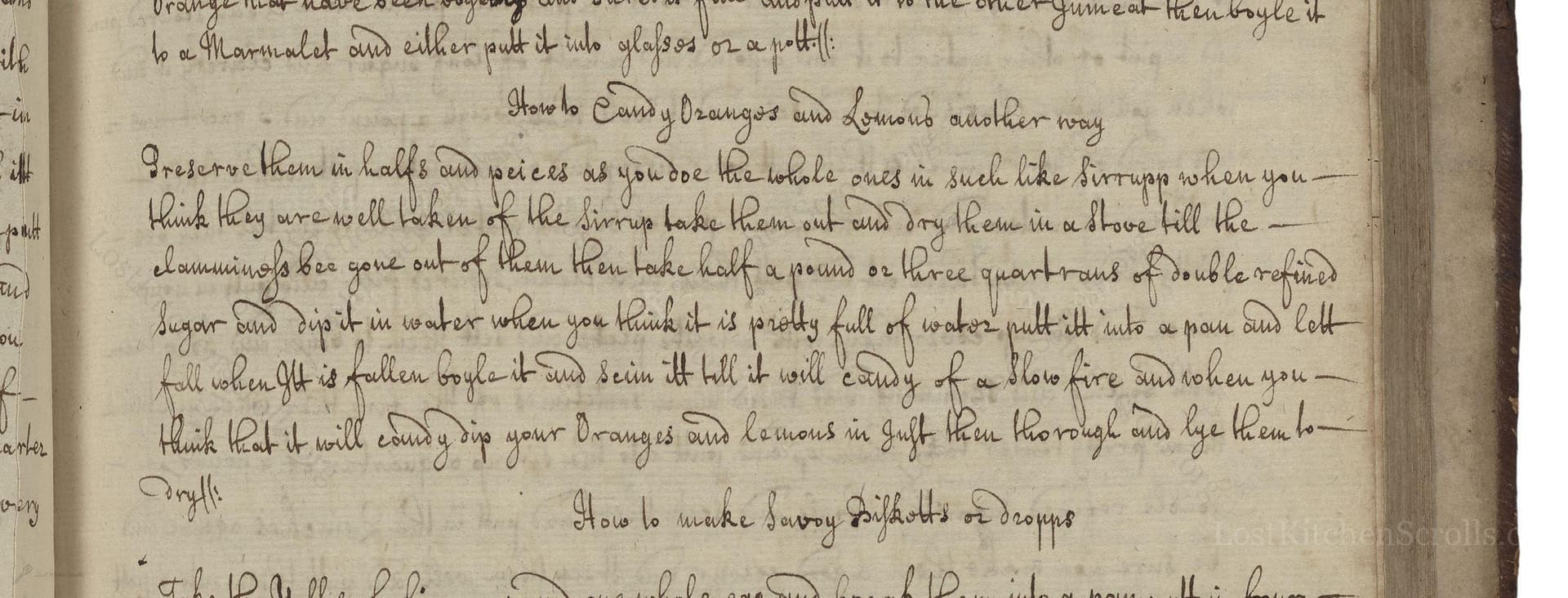How To Candy Oranges And Lemons Another Way
From the treasured pages of Mrs. Rachel Kirk Book 1707
Written by Rachel Kirk

How To Candy Oranges And Lemons Another Way
"Preserve them in halfs and peices as you doe the whole ones in such like Sirrupp when you think they are well taken of the Sirrup take them out and dry them in a stove till the clammines bee gone out of them then take half a pound of double refined sugar and dip it in water when you think it is pretty full of water putt it into a pan and lett it boyle and scim it till it is fallen boyle it and scim it till itt is allmost candy then dip your Oranges and lemons in just then thorough and lye them to dryll:"
Note on the Original Text
Historically, recipes like this were written as brief, almost cryptic instructions, intended for skilled readers who already understood preparation methods. Measurements were often approximate or based on experience, reflecting a hands-on, intuitive approach. Spelling variations ('Sirrupp' for syrup, 'boyle' for boil, 'scim' for skim, 'bee' for be, 'thorough' for through) are common, as standardized English was still developing. Recipe writers assumed their audience could fill in missing steps and adapt to available equipment or ingredients.

Title
Mrs. Rachel Kirk Book 1707 (1707)
You can also click the book image above to peruse the original tome
Writer
Rachel Kirk
Era
1707
Publisher
Unknown
Background
A remarkable collection of early 18th-century recipes, Rachel Kirk's work invites readers into the kitchens of the past where classic culinary traditions and timeless flavors come alive. Expect a charming medley of savory feasts and sweet treats reflective of the era's sophisticated palate.
Kindly made available by
Folger Shakespeare Library
This recipe comes from early 18th-century England, specifically from Rachel Kirk's manuscript dated 1707. During this time, the practice of preserving citrus fruits, particularly imported ones such as oranges and lemons, was both a culinary delicacy and a necessity in the absence of refrigeration. The technique of candying was a popular way to extend the shelf life of these prized fruits while turning them into luxurious treats suitable for special occasions or displays of hospitality. Sugar was an expensive commodity, signaling wealth and status. Recipes like this one often appeared in the recipe books of affluent households, reflecting both the global trade networks of the period and the sophistication of English confectionery arts.

In the early 1700s, this recipe would have been made using heavy copper or brass preserving pans set over a gentle coal or wood fire. A skimmer (often a slotted spoon) would be used to remove impurities or scum from the sugar as it boiled. The fruit would be dried either in a dedicated drying stove (a low, gently heated oven) or beside the hearth. Finished candies would be laid on wire racks, wooden trays, or sheets of coarse paper.
Prep Time
25 mins
Cook Time
1 hr 10 mins
Servings
10
We've done our best to adapt this historical recipe for modern kitchens, but some details may still need refinement. We warmly welcome feedback from fellow cooks and culinary historians — your insights support the entire community!
Ingredients
- Oranges (as many as desired)
- Lemons (as many as desired)
- Granulated sugar, for the initial syrup (equal weight to fruit)
- Water, enough to make syrup (equal volume to sugar)
- 8 ounces caster or superfine sugar (double refined, for candying)
- 2-3 tablespoons water (for the candying syrup)
Instructions
- Begin by cutting oranges and lemons into halves or pieces.
- Preserve these in a syrup, following the same method as for preserving whole fruits: simmer the fruit gently in a sugar syrup (use equal parts water and sugar), until the rind softens and the syrup has soaked into the fruit.
- When the fruit is sufficiently impregnated with syrup, remove and dry it in a warm spot (about 120°F in a dehydrator or a low oven) until it loses its stickiness.
- Separately, take 8 ounces (about half a pound) of caster sugar, immerse it in just enough water to wet it thoroughly (about 2-3 tablespoons), and heat it in a pan.
- Boil and skim as necessary.
- Continue boiling until the sugar reaches the thread or soft ball stage (approximately 234-240°F), just before it begins to crystallize.
- Quickly dip each dried piece of fruit into this hot sugar syrup to coat, then lay them out on a rack or parchment to dry completely.
Estimated Calories
90 per serving
Cooking Estimates
It takes about 25 minutes to slice fruit and get the syrup started. Simmering and soaking the fruit in syrup takes about 1 hour. Drying the fruit may need up to 3 hours, and dipping in hot sugar takes only 10 minutes. Each candied fruit serving has roughly 90 calories, mostly from sugar. The recipe makes about 10 servings, depending on the size of the fruit pieces.
As noted above, we have made our best effort to translate and adapt this historical recipe for modern kitchens, taking into account ingredients nowadays, cooking techniques, measurements, and so on. However, historical recipes often contain assumptions that require interpretation.
We'd love for anyone to help improve these adaptations. Community contributions are highly welcome. If you have suggestions, corrections, or cooking tips based on your experience with this recipe, please share them below.
Join the Discussion
Rate This Recipe
Dietary Preference
Main Ingredients

Den Bockfisch In Einer Fleisch Suppen Zu Kochen
This recipe hails from a German manuscript cookbook compiled in 1696, a time whe...

Die Grieß Nudlen Zumachen
This recipe comes from a rather mysterious manuscript cookbook, penned anonymous...

Ein Boudain
This recipe comes from an anonymous German-language manuscript cookbook from 169...

Ein Gesaltzen Citroni
This recipe, dating from 1696, comes from an extensive anonymous German cookbook...
Browse our complete collection of time-honored recipes



